Physical Address
304 North Cardinal St.
Dorchester Center, MA 02124
Proximal humerus fractures in the pediatric and adolescent population are relatively rare, constituting less than 3% of all children’s fractures and accounting for 3% to 7% of physeal fractures. Nonoperative treatment is the standard of care in most skeletally immature patients, given the significant remodeling potential of the proximal humeral physis, but depends on the degree of displacement and angulation, so treatment must be individualized based on age and radiographic findings. For overall upper extremity function, even moderately nonanatomic reduction is generally well compensated by shoulder and distal joint mobility.
Despite the majority of literature demonstrating successful nonoperative management in young patients, some complications exist, most commonly arising from residual angulation and/or shortening. Many of the previous studies investigating the incidence of these complications analyzed the full breadth of fracture patterns in pediatric populations, including minimally displaced fractures and younger age groups with inherently greater remodeling capacity, which may result in extremely low rates. In the adolescent population nearing skeletal maturity, however, there is a much higher incidence of complications with nonoperative treatment, establishing a clear rationale for operative treatment of severely displaced and angulated proximal humerus fractures (Neer–Horowitz type 3 and 4) ( Fig. 1.1 ). Such patients have more limited remodeling potential, more incidence of impediments to anatomic closed reduction attempts, and often greater biomechanical demands on the shoulder, with therefore greater implications of restricted function and mobility in the setting of metaphyseal malunion. Stemming from greater understanding of the differences in displaced proximal humerus fractures in adolescents, compared with their younger pediatric counterparts, there has been a recent trend towards increased surgical management of skeletally immature proximal humerus fractures.
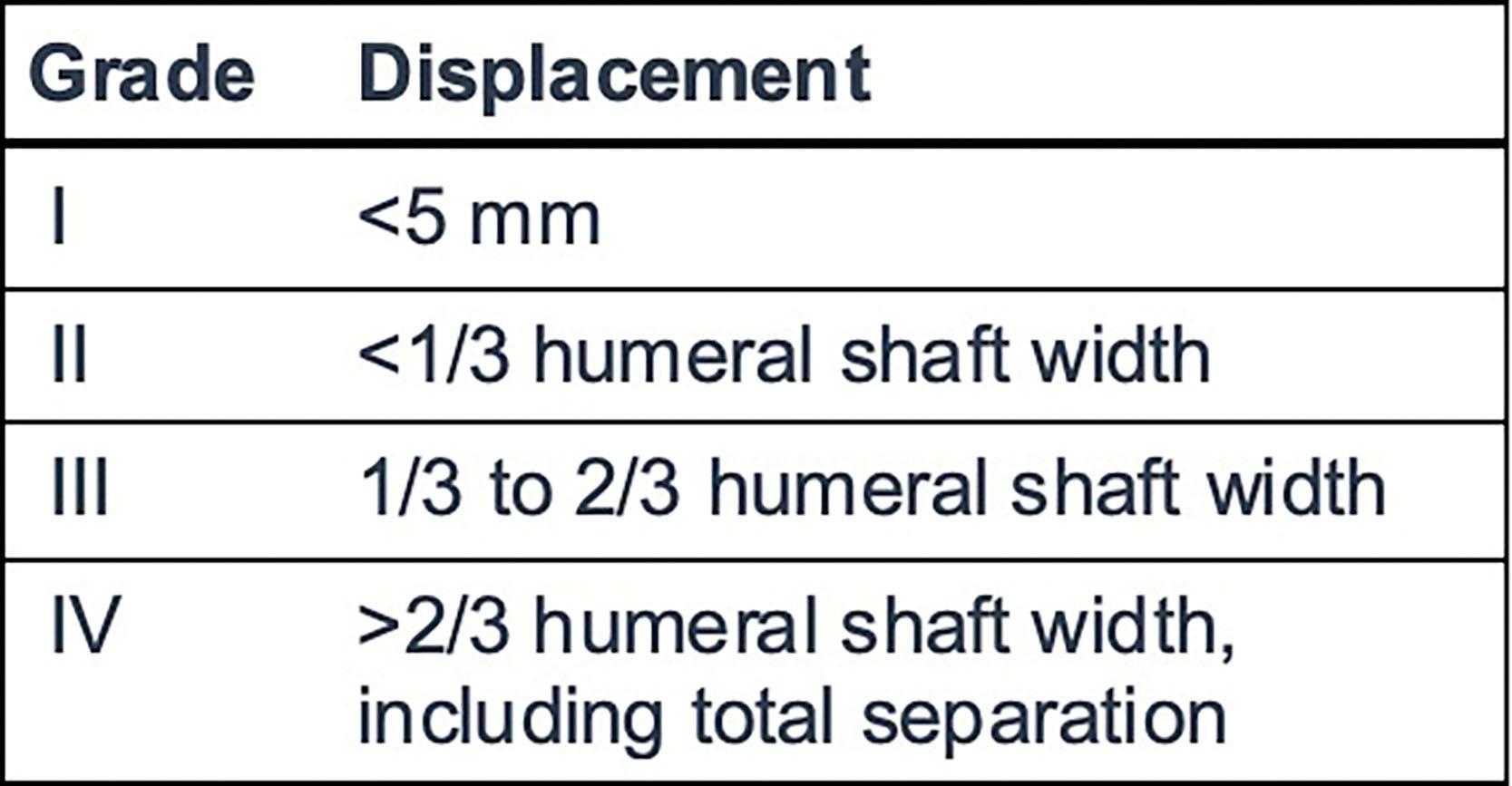
In the pediatric and adolescent populations, proximal humerus fractures most often result from moderate- or high-energy trauma, with a strong predilection for males. Indirect trauma to an outstretched, abducted, and externally rotated upper extremity is a more common mechanism than a direct blow to the shoulder girdle. The resultant injury is typically extracapsular, affecting the metaphyseal or physeal regions, with Salter-Harris II morphology being the most common pattern. Lower energy fractures should raise suspicion for pathologic or neoplastic etiology, as proximal humerus fractures are often associated with unicameral bone cysts (UBCs) and aneurysmal bone cysts. The “fallen leaf sign” is a classic radiographic finding associated with UBC, and may be helpful in diagnosis, which can be further corroborated by magnetic resonance imaging (MRI) versus computed tomography (CT).
The proximal humeral physis contributes to approximately 80% of longitudinal growth of the humerus, thereby exhibiting tremendous metabolic activity in adolescence and an underlying capacity for fracture remodeling. Predictably, younger patients have a higher propensity to remodel, and therefore nonanatomic reduction of the proximal humerus may be more readily accepted in children under 13 years of age ( Fig. 1.2 ). Because final fusion of the proximal humeral physis is typically anticipated at age 14 to 17 years in females, and 16 to 18 years in males, decision-making for patients 14 to 18 years of age must be more individualized based on displacement and angulation.
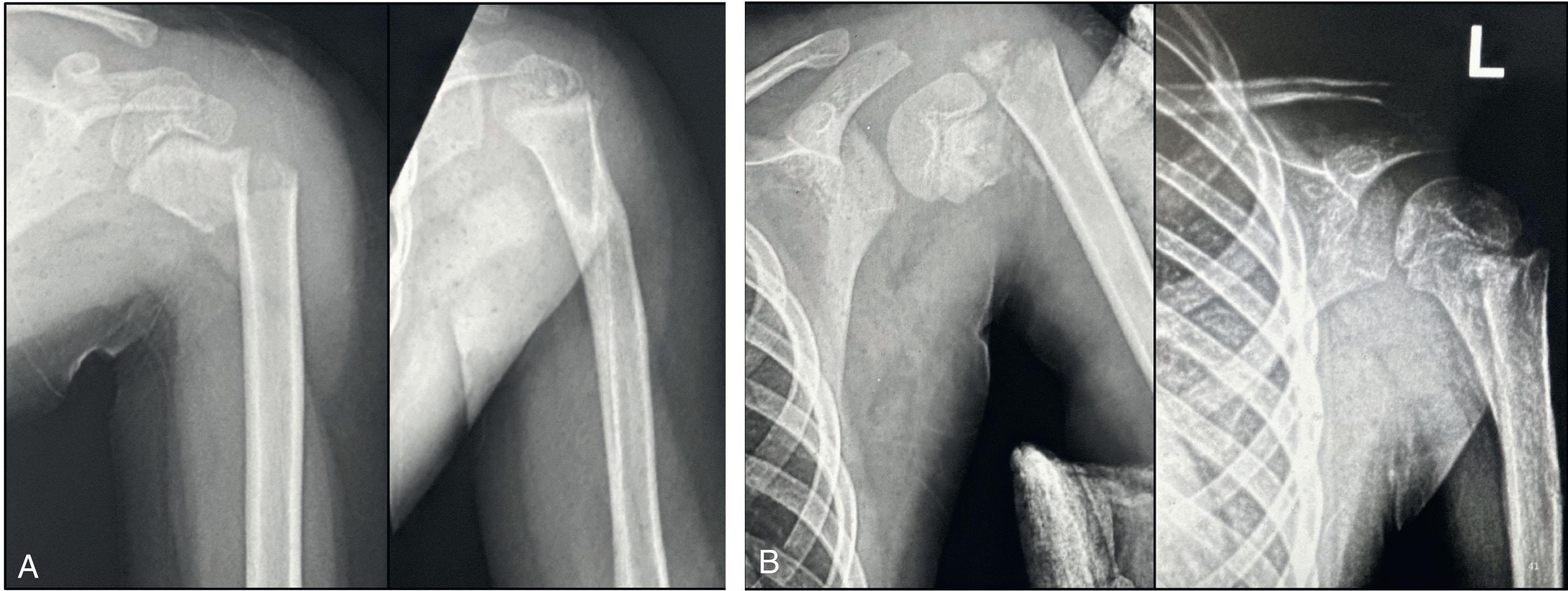
Vascularity to the proximal humerus is predominantly supplied by the posterior circumflex humeral branch off the axillary artery. This notion may be relevant in the prediction and prevention of humeral head osteonecrosis, an extremely rare complication in the skeletally immature population. An intact posteromedial metaphyseal hinge seen on plain radiographs is typically consistent with an intact posterior humeral circumflex artery.
The axillary nerve is in close proximity to the proximal humerus and may be vulnerable to insult with any proximal humerus fracture, glenohumeral dislocation, or operative intervention on the proximal humerus. Anatomic studies have demonstrated that lateral pins inserted for percutaneous treatment of proximal humerus fractures may reside as near as 3 mm to the axillary nerve. To mitigate the potential risk of axillary nerve injury with lateral percutaneous pin fixation, the starting point for the proximal most pin should be greater than 5 cm distal to the anterolateral corner of the acromion, which represents the typically level of the axillary nerve in adults with arm in neutral abduction and rotation. This distance may be inaccurate in skeletally immature patients with shorter appendages, and therefore care must be taken to identify other anatomic landmarks that can help identify the level of the axillary nerve. The glenoid neck is one such landmark. The axillary nerve enters the quadrangular space from its origin on the posterior cord of the brachial plexus, which coincides with the inferior margin of the glenoid neck. With a more anterior pin entry or errant lateral pin, the musculocutaneous nerve may be at risk as it enters the posterior aspect of the coracobrachialis in a medial to lateral direction inferior to the coracoid.
Patients with minimally displaced or nondisplaced proximal humerus fractures will typically present with mild swelling and focal tenderness to the proximal humerus region, with minimal apparent deformity. Greater degrees of physeal displacement may be accompanied by more significant fracture hematomas, therefore accounting for increased edema and ecchymosis. Acutely, pain is exacerbated with attempted shoulder motion. A displaced proximal humerus fracture will typically present with the appearance of a shortened and rotated extremity, classically apex anterior and varus.
In both nondisplaced and displaced fractures, skin should be carefully assessed for any potential compromise or impending open injury. In conscious patients, while neurovascular injuries associated with proximal humerus fractures are relatively rare, occurring less than 1% of the time, an accurate neurovascular assessment is essential to evaluate for vascular, brachial plexus, or peripheral nerve injuries and to provide a baseline from which to gauge progression of symptoms.
Standard radiographs of the shoulder, including anteroposterior (AP), lateral, and axillary views, should be routinely acquired in the assessment of proximal humerus fractures. In circumstances where axillary views may not be possible, a scapular Y view or Velpeau view should be obtained to ensure glenohumeral joint reduction, though dislocations associated with humerus fractures are rare, estimated at around 2%. Radiographs should be critically assessed for pathologic fracture.
In patients nearing skeletal maturity, an assessment of skeletal age may be helpful. Historically, left hand bone age radiographs have been used to provide a more accurate determination of potential remaining growth. More recent work by Li et al. has provided a system by which to estimate skeletal age based on proximal humeral physeal features. While the fracture itself may confound one’s ability to accurately assess such features, all caregivers of pediatric patients with shoulder conditions should be familiar with the system. Overall, skeletal age information may have value in the management of highly unstable or severely displaced fractures, in which a fixation construct that crosses the physis may be desirable to maintain fracture stability. However, as upper extremity limb length differences are generally not a concern after adolescent fractures, bone age determinations are more relevant to estimating remodeling capacity than concerns about iatrogenic physeal closure.
If elastic stable intramedullary nailing (ESIN) is being considered for internal fixation, a calibrated radiographic assessment of the diaphyseal medullary canal diameter is necessary to select appropriate diameter nails, as achieving approximately 60% to 80% fill with the two implants at the level of the humeral isthmus is a frequently utilized parameter ( Fig. 1.3 ).
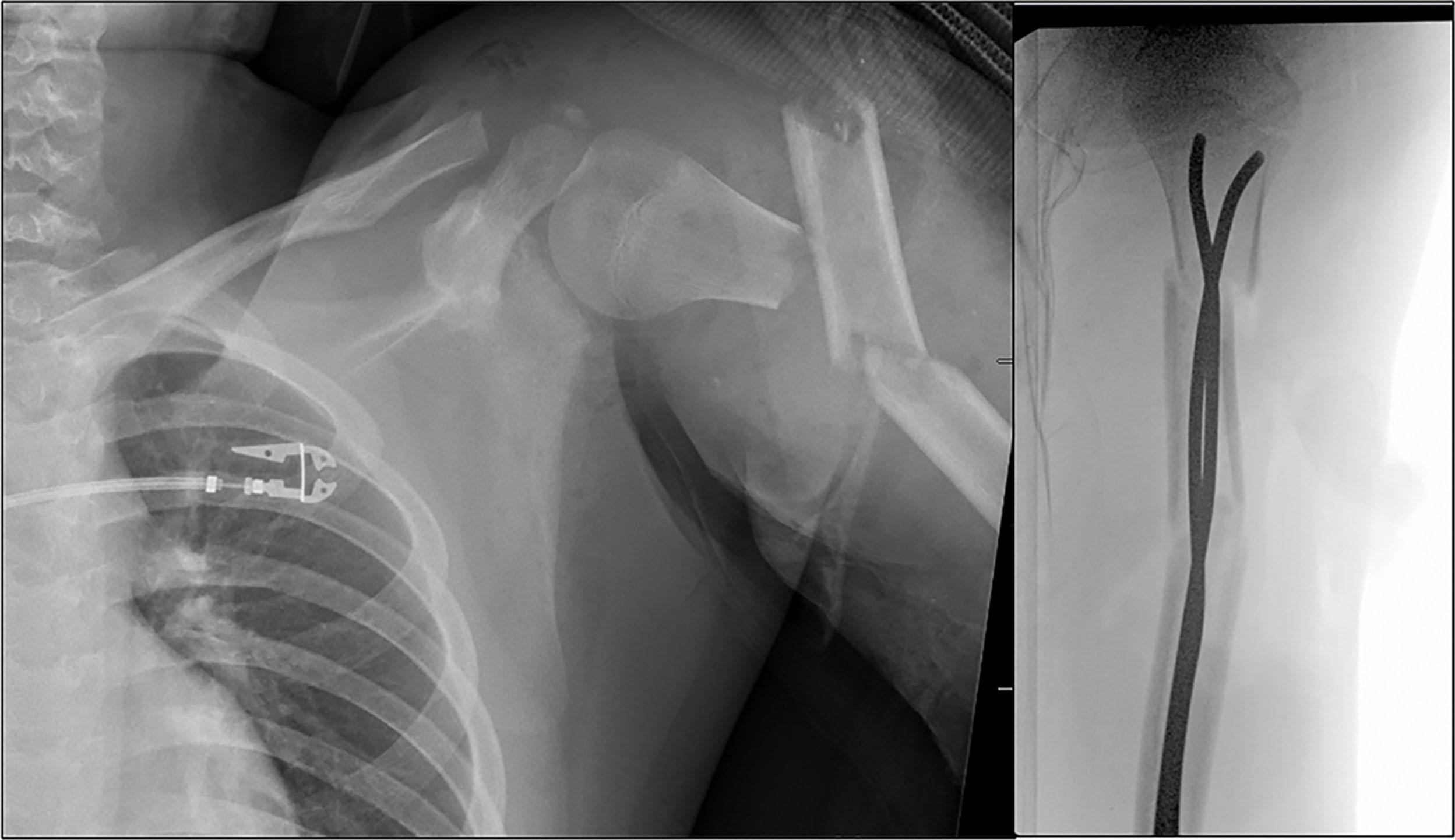
Advanced imaging is rarely indicated in the routine assessment of skeletally immature proximal humerus fractures. A CT scan can aid in the identification of complex concomitant bony pathologies that are sometimes seen with higher-energy mechanisms of injuries or pathologic fractures. These include glenoid fractures, glenohumeral fracture/dislocation, significant comminution, and/or neurovascular injury. Alternatively, MRI may provide a radiation-free adjunctive radiologic tool to aid in diagnosis and treatment algorithm for suspected pathologic fractures or suspected soft tissue injury.
Absolute indications for surgical intervention include open fractures, fractures with impending skin compromise, and fractures with associated or evolving vascular compromise.
Relative indications for surgery remain controversial. Most utilize an age-based algorithm for decision making, with lower thresholds for surgery in patients older than 12 years related to a diminished ability to remodel and inferior outcomes with increased age. Other significant considerations are radiographic translation of fracture fragments (>50%) and, perhaps most importantly, angulation (>40 to 45 degrees), alone. Varus angulation is common, given the strong pull of the rotator cuff sleeve on the proximal fragment. Definitive healing in this position, if excessive, may result in a malunion that limits normal degrees of shoulder abduction.
While uncommon in this population, concurrent glenohumeral dislocation should warrant prompt reduction to preserve blood supply. Possibility of open joint reduction should be anticipated, given the challenge of controlling and providing adequate leverage to the proximal segment with closed reduction.
In the setting of higher-energy trauma or polytrauma, triaging of limb- or life-threatening injuries should be prioritized, requiring expeditious but meticulous secondary surveys and adequate imaging. Polytrauma patients may benefit from operative care to facilitate overall management.
Multiple viable internal fixation options exist for managing proximal humerus fractures in skeletally immature patients, including percutaneous pin or screw fixation, ESIN, and plate osteosynthesis. Appropriate treatment should be stratified on the basis of patient development (chronologic and skeletal maturity) and radiographic parameters (displacement, angulation, rotation, and shortening). Goals of stabilization include restoration of acceptable alignment to prevent lasting abnormal shoulder function and stable fixation to permit early postoperative mobilization.
Historically, percutaneous pin fixation has been well described and is the most common technique for operative fixation of pediatric and adolescent proximal humerus fractures. In contrast to ESIN, percutaneous pinning is relatively technically simple, with shorter operative times, and may be better indicated for very proximal fractures.
Smooth k-wires are more commonly utilized than threaded k-wires, given the ability to remove them without sedation in the clinic setting after adequate healing is achieved. However, for more unstable fractures, threaded k-wires may be advantageous, and may be removed in a minor secondary procedure in the operating room with light sedation. Given that smooth k-wire fixation provides more relative stability, adjunctive sling immobilization is an important element in the first 3 to 4 weeks postoperatively to minimize fracture site motion. An increasingly popular alternative to k-wire fixation is use of one to two cannulated screws, which generally confers more rigid stability and does not require removal. This option may be more particularly suited for older adolescents in whom considerations toward continued proximal humeral growth may be minimal.
Percutaneous pin fixation carries risk of irritation to adjacent soft tissue and muscles, and may lead to pin site issues such as infection or focal sites of skin necrosis. This should be contemplated in obese patients; younger, noncompliant patients; or those with behavioral issues who may have difficulty adhering to activity restrictions, where soft tissue motion may be excessive. Buried pins will require a second operation for removal, but may be a good option for such patients.
Other complications of percutaneous pins include migration and associated perforation of the humeral head.
Use of retrograde ESIN, which involves introducing nails percutaneously or through a mini-open incision at the level of the distal humerus, has received increased support in contemporary operative techniques, due to some inherent biologic and mechanical advantages associated with the intramedullary technique. ESIN preserves the periosteum around the fracture site without compromising adjacent soft tissues or the glenohumeral joint. Additionally, ESIN has been found to be more favorable for early mobilization of the injured extremity. Overall, ESIN has demonstrated a low complication rate, with the most prominent complications including perforation of a nail through the humeral head and inadequate stabilization leading to loss of reduction. In general, this technique is best suited for displaced metaphyseal or physeal fractures, as it may be difficult to obtain adequate bony purchase with more proximal injuries.
Although some fractures or clinical scenarios may allow for use of a single intramedullary nail for achieving stability, studies have shown decreased complication rates with use of a two-nail technique in comparison to one-nail technique ( Fig. 1.4 ).
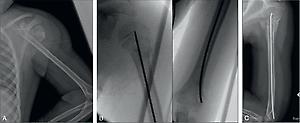
Potential disadvantages of ESIN may include increased technical demand, longer surgical time, higher expected blood loss, and routine need for implant removal with a secondary anesthesia, given that the implants are placed in buried fashion.
In general, plate fixation techniques for primary fractures should be limited to rare scenarios of patients with closed or closing physes with such severe displacement or comminution that extra stability beyond pin or screw fixation may be needed. Additionally, this technique could be considered in skeletally immature patients with less than 2 years of growth remaining or in circumstances of secondary displacement.
The patient is positioned supine or in a modified beach chair position. This positioning is consistent across all fixation methods. We recommend prepping and draping of the entire arm and shoulder girdle, use of an interscapular bump, and head positioning with slight deviation and/or tilt toward the contralateral side to facilitate access and reduction. Relaxation of shoulder musculature is essential for reduction of more displaced fractures, and this should be considered prior to the start of the case as part of the anticipated anesthesia plan. Use of a pneumatic-controlled arm holder or related equipment to provide adjustable but stable arm positioning in three degrees of freedom can be extremely helpful, as maintenance of reduction during fluoroscopy can be particularly challenging.
The classic displacement for proximal humerus fractures is apex anterior and varus angulation. In performing closed reduction maneuvers, it is imperative to understand the primary musculotendinous deforming forces acting on the humerus. The distal component is typically internally rotated and adducted, secondary to pectoralis major, latissimus dorsi, and teres major attachments. The proximal component is typically abducted and externally rotated, as a result of the supraspinatus, infraspinatus, and teres minor (rotator cuff) forces. Thus, reduction is most often accomplished by initial abduction, forward flexion, and external rotation of the arm, bringing the distal to the proximal segment, with the addition of axial traction, to disengage the fracture.
Inability to obtain and/or maintain satisfactory alignment with closed reduction usually warrants open reduction. The most common impediments to adequate closed reduction include entrapment of long head biceps tendon, periosteum, and/or capsule. In general, interposition of soft tissue should be suspected with inability to reduce or gapping at the fracture site and can be addressed effectively with careful open extraction.
We recommend a standard deltopectoral approach for open reduction. This approach provides optimal access to the anterior shoulder, the glenohumeral joint, and the biceps tendon, which is most commonly interposed. Notably, this approach can be extensile if necessary, by extending into an anterolateral approach. As an alternative, the proximal humerus may be accessed through a lateral deltoid muscle splitting interval. This approach allows better access to the posterolateral shoulder and displaced greater tuberosity fractures, which are rare in adolescents and more characteristic of adult fracture patterns.
Percutaneous pin fixation is most often performed with smooth k-wires, though some surgeons may favor threaded k-wires in some situations or fracture patterns. The planned skin incision for pin introduction is marked 5 to 6 cm distal to the anterolateral corner of the acromion to minimize the risk of iatrogenic axillary nerve injury. This corresponds to the described level of the axillary nerve and should be the proximal-most entry point for a lateral pin. Appropriate trajectory of the pin is confirmed with fluoroscopy prior to making an incision. A 1-cm longitudinal skin incision is then made slightly more distal to minimize skin tension. Blunt dissection to bone is undertaken to minimize risk to the axillary nerve and posterior humeral circumflex artery. A slightly broader deep dissection may better accommodate mobilization during imaging and minor adjustments to starting point and trajectory. External rotation during pin placement may further protect the posterior humeral circumflex artery. For distal to proximal pins, these may be safely advanced into the epiphysis, due to the typical brief duration of pin retention ( Fig. 1.5 ). Pins should be advanced to within 5 mm of subchondral bone, with care taken not to penetrate the glenohumeral joint. Alternatively, pins may be directed proximal to distal, with care taken to avoid neurovascular structures inferior to the humeral head and neck. Advancing pins on oscillate may also decrease risk of injury to nearby structures. Construct stability is typically achieved with two divergent or, less commonly, cross pins. Following definitive fixation, we recommend dynamic fluoroscopic assessment to ensure adequate fracture stability throughout and absence of glenohumeral penetration. Any pins appearing to be too long should be withdrawn to appropriate length.
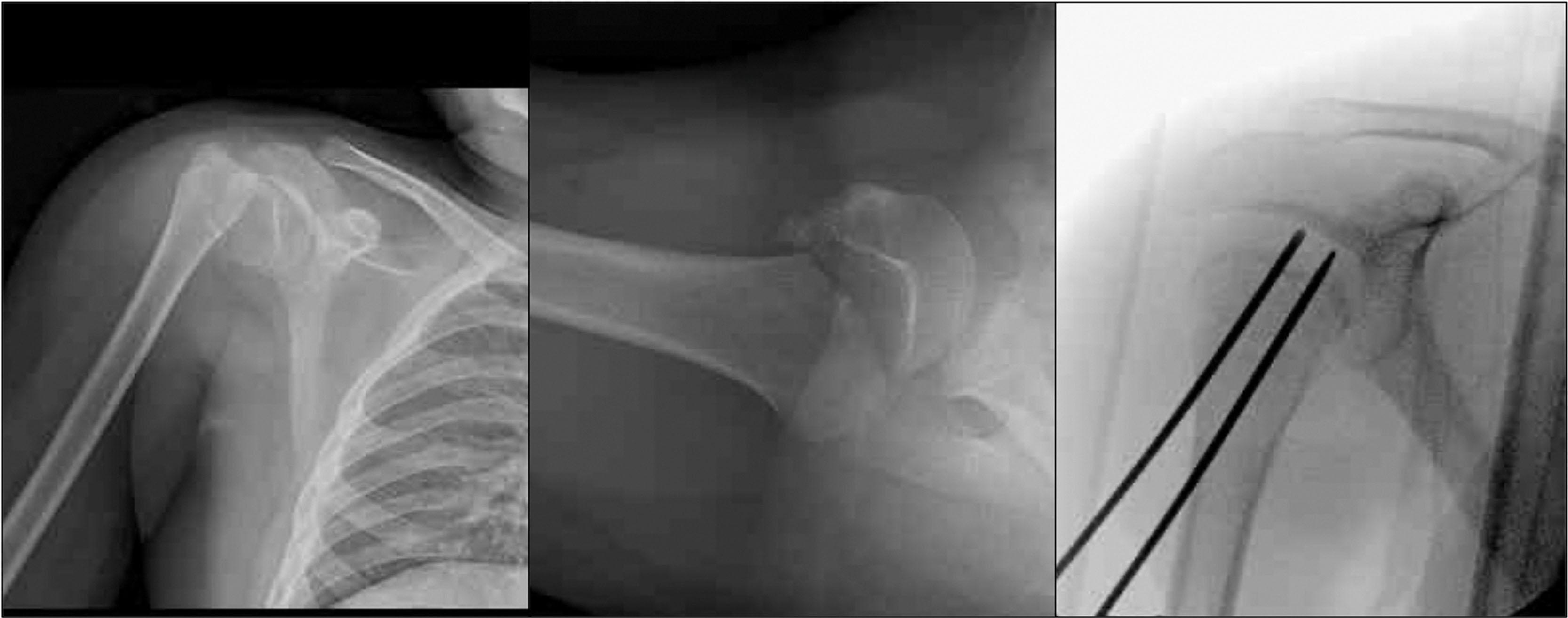
In determining whether pins should be buried or left exposed, this should be considered on an individualized basis, with excessive adjacent soft tissue movement posing greatest threat for pin site infection with exposed pins. We recommend relief of any tension at the skin–pin interface. Buried smooth pins may minimize the incidence of pin migration or pin site infections. With buried pins, it is essential to ensure pins are sufficiently deep to not compromise overlying soft tissue, with the obvious disadvantage of requiring a secondary surgery with anesthesia to remove the pins, whereas pins that are left percutaneously may be removed in the office setting.
Postoperatively, we recommend sling immobilization, with or without a swath component, or a supportive abduction pillow, for 4 to 8 weeks, with adequate fracture stability often obtained after this period due to early healing.
Although less commonly used, historically, than smooth k-wire fixation, some emerging literature and technique papers have led to increased popularity of screw fixation, which may be particularly suited for older adolescents. The technique is fairly similar to the smooth k-wire technique but involves smaller wires that serve as guidewires for the cannulated drill and screws, which may be fully threaded or partially threaded, with 4.5-mm diameter cannulated screws representing the most commonly utilized size.
ESIN is typically performed retrograde, with two lateral entry nails placed through an entry point proximal to the olecranon fossa. Nail diameter is predicted preoperatively based on the goal of 60% to 80% canal fill at the isthmus. Nail diameter can be additionally confirmed prior to incision by laying the nail over the humerus and radiographically ensuring appropriate canal fill. A 2-cm skin incision is made proximal to the lateral epicondyle of the humerus. Blunt dissection is carried down to bone, which minimizes the risk of injury to the lateral antebrachial cutaneous and radial nerves. The lateral cortex is penetrated obliquely in a distal to proximal direction with a drill or awl, and the first nail is advanced gently to fracture site. Care is taken to avoid perforation of the opposing cortex. A second nail is inserted into an adjacent lateral cortex insertion point and advanced in similar fashion. Under fluoroscopic guidance, the fracture is reduced, and the nails are slowly malleted beyond the fracture site into the proximal fragment and appropriately rotated for divergence, to complement desired alignment and counteract tendency for varus collapse. Attention must be given to avoid fracture overdistraction and ensure the nails do not wind around each other during rotation. Once final fixation has been achieved, dynamic fluoroscopic assessment with the arm in different positions is warranted to confirm fracture and construct stability and to rule out cortical or joint violation. Following satisfactory fixation, nails are cut near their distal cortical insertion point, approximately 5 to 10 mm from the cortex, to minimize adjacent soft tissue irritation and to maintain access for future retrieval.
Antegrade nails are not advocated in skeletally immature patients, as they would have to cross the proximal physis and/or rotator cuff. Medial epicondylar entry points are typically avoided, due to proximity to the ulnar nerve.
Plate osteosynthesis is much less common in skeletally immature patients. Given the need for open approach for fixation, we recommend this be performed in a biologically friendly manner, with emphasis on preservation of periosteum and soft tissue, and care taken with screw fixation to minimize risk of joint penetration and physeal-sparing screw placement.
Become a Clinical Tree membership for Full access and enjoy Unlimited articles
If you are a member. Log in here